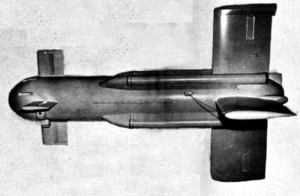| KAN Little Joe | |
|---|---|
 | |
| Type | Surface-to-air missile |
| Place of origin | United States |
| Service history | |
| Used by | United States Navy |
| Production history | |
| Designed | 1945 |
| Manufacturer | Naval Air Material Unit |
| Produced | 1945-1946 |
| No. built | 15 |
| Specifications (KAN-1) | |
| Mass | 1,210 pounds (550 kg) |
| Length | 11 feet 4 inches (3.45 m) |
| Diameter | 22.7 inches (57.7 cm) |
| Wingspan | 7 ft 7 in (2.31 m) |
| Warhead | High explosive |
| Warhead weight | 100 pounds (45 kg) |
Detonation mechanism | Proximity fuze |
| Engine | Booster, 4x 3 in (76 mm) rockets 990 lbf (4.4 kN) each Sustainer, Aerojet 8AS1000 990 lbf (4.4 kN) |
Operational range | 2.5 miles (4.0 km) |
| Flight ceiling | 7,900 feet (2,400 m) |
| Maximum speed | 400 miles per hour (640 km/h) |
Guidance system | Radio command |
The Little Joe, also known by the United States Navy designation KAN, was an early American ship-based, short-range surface-to-air missile, the development of which was initiated in 1945 as a response to the Kamikaze tactics used by the Japanese. Although the missile was successfully tested, the end of World War II removed the requirement for the missile, and the project was abandoned in 1946.